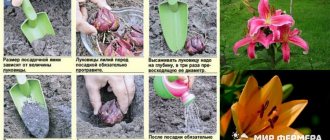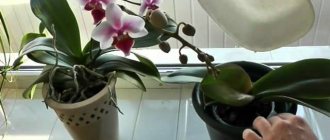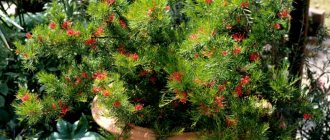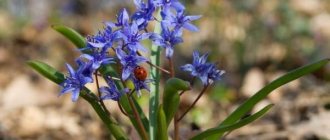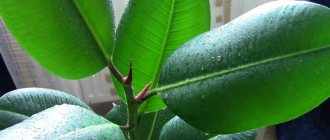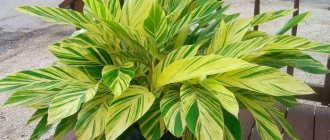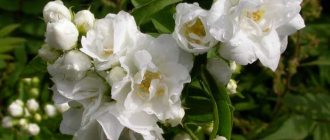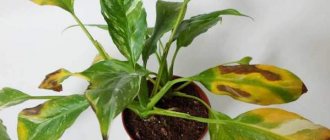Jugs
The flower of the “female” type has a more convex base and its appearance somewhat resembles a small jug. The edges of the “neck” of the jug are decorated with triangular dense teeth, which turn into a crown on an adult fruit. The pistils of the “female” flower are quite long and are located at or above the stamens.
Such inflorescences do not form on young shoots less than one year old. The ovary of the bud consists of several nests, which, when the fruit ripens, are filled with grains.
What is a pomegranate tree: the meaning of the name
Pomegranate is a fruiting shrub or tree.
Its generic name comes from the Latin word "punicus", meaning Punic. The specific name comes from the word “granatus” , which translates as granular, due to the many juicy grains inside the fruit.
In the Middle Ages, the pomegranate was called the seed apple (Pomum granatum). The ancient Romans gave it the name granular apple (malum granatum). This fruit is called an apple in different languages: Italians – melograno, Germans – Granatapfel.
In the old days, the pomegranate was called the royal fruit, because of the shape of its upper part , which resembles a crown, as well as for its healing properties, which can help in the treatment of certain diseases.
The Greeks called the pomegranate the “fruit of happiness.” They had the custom of throwing these fruits at the feet of newlyweds so that their family would be rich and abundant, just as it is filled with sweet pomegranate seeds.
Bells
The buds of “male” inflorescences, unlike “female” ones, have a narrower part at the base and a wider part at the end. Thanks to this, their appearance resembles bells.
The pistils of these cute bells are short and hidden inside the anthers. Such inflorescences most often appear on fresh branches of the current year and, after they bloom, simply fall from the tree.
The ratio of the total number of “male” and “female” inflorescences most often depends on a particular variety. Additionally, this point can be influenced by proper care and environmental conditions.
History of selection and appearance of pomegranate
Mention of the pomegranate is present in Ancient Greek mythology. In these works, the fruit was presented both as a symbol of abundance and immortality, and as a sign of oblivion and death. Since ancient times, this fruit crop has been found throughout the Mediterranean coast.
Residents of Ancient Greece were sure that the pomegranate fruit was created from the blood of Dionysus, the god of wine. For Christians, the pomegranate fruit was a symbol of resurrection and was associated with the image of the Virgin Mary. Many ancient paintings depict the Virgin Mary and the baby Jesus holding a magical fruit in their hands. After research, scientists suggested that the birthplace of the pomegranate tree could be Persia (Iran).
Today the plant is widespread in the Caucasus, Asia, Iran, Afghanistan, Central Asia and other countries with tropical and subtropical climates, as well as throughout the Mediterranean. The plant was brought to Crimea by the Greeks.
Color spectrum
The color palette of a plant such as pomegranate is varied only in scarlet, crimson, pink and white shades. There are varieties of variegated inflorescences.
The shape of the flower can be so unusual and elegant that at first glance it is impossible to understand what kind of plant it is.
Description of the plant
The photo of a homemade pomegranate shows oblong-shaped leaves with sharp tips. The portrait of a native of Asia Minor is complemented by a brown with a light tint with branches; there are thorns on the branches.
The pomegranate flower boasts an unusual shape; there are petals around the red perianth that cover it; their colors vary: scarlet, yellow and white, it all depends on what variety it is.
Pomegranate flowering time
A plant grown from a seed usually blooms after 3-4 years, for a pomegranate grown from a cutting - 2-3 years. Sometimes pomegranates bloom abnormally early, usually in this case only a few buds bloom and subsequently fall off.
Pomegranate, when grown at home, has two flowering periods. The first flowering occurs in April-May, the second in August. Despite the fact that one bud fades in 3-4 days, it is immediately replaced by another bud, and this continues until the end of the entire period.
Until autumn, the plant shines with flowers like garlands. It is especially interesting to watch the formation of buds, flowering and fruit formation - at such moments the pomegranate looks very luxurious and fabulous.
What do they look like?
There are many different varieties of pomegranate. Some are spreading trees, others grow in the form of shrubs, and still others are dwarf varieties that are grown indoors. Regardless of the variety, pomegranate flowers are very bright, large and showy.
Description and photo of a flowering plant
It is very interesting to watch the blossoming of a pomegranate: first, with a characteristic sound, the dense, fleshy shell of the bud bursts , from which petals eventually appear.
When the flower just begins to bloom, its petals look slightly crumpled, but after 1-2 days they straighten out, taking on the shape of a bell or water lily.
In regions with a warm climate, for example, in Sochi, you can find varieties with lush double flowers. Their petals can be colored crimson, red-orange, yellow, white, white-orange. Hybrid varieties of indoor pomegranate also have double, rather lush flowers.
The peculiarity of the pomegranate tree is that flowers form on its branches throughout the season. Therefore, on one tree you can see both already ripe pomegranates and buds, flowers, or fruits just beginning to form.
Botanical characteristics
Pomegranate flowers can be of 3 types:
- Male - their shape resembles a large bell with long stamens and short pistils.
- Female ones are shaped like a water lily with long pistils. After flowering ends, an ovary forms.
- Sterile - have the shape of bells, which are noticeably smaller in size than female and male ones, but there are the most sterile flowers on pomegranate trees.
The fruits are formed only from female flowers, the buds of which are similar in appearance to a fleshy tube with a jagged edge. After the fruit is formed, this edge is retained on its upper part in the form of a small crown.
The formation of female flowers is possible only on last year's strong shoots . Their internal part is a multilocular ovary, formed from fused stipules, from which small chambers with grains will later form.
Compared to sterile and male flowers, there are approximately 5 times fewer female flowers on trees.
Male bells have cone-shaped buds that fall off after 3-4 days of flowering. The shape of sterile flowers, which also do not form fruits, can be either cone-shaped or in the form of a cylinder or jug.
The diameter of the flowers ranges from 5 to 7 cm, while the sterile flowers are smaller compared to the female and male ones.
How pomegranate blooms is described in the video:
Natural flower drop
As we already understood, pomegranate buds falling off during flowering is a normal phenomenon. In this regard, the plant itself determines how many flowers it can withstand, so that in the future it does not become depleted. This is a natural process not only for the common pomegranate, which grows outdoors, but also for a similar indoor plant, for example, such as the dwarf pomegranate.
Whatever the variety, if the tree bears fruit, then the falling off of the inflorescences is inevitable. And let us remind you that it is mainly “male” specimens that fall off - barren flowers.
Popular varieties of pomegranate for the home
| Name | Description |
| Carthage, Baby | No more than a meter in height. They are similar to the common pomegranate, but are smaller in size. They are grown for decorative purposes; the fruits are not eaten. |
| Flore Pleno | Grows in Persia, does not produce crops. Grows up to three to four meters. The bright scarlet inflorescences look like carnations. |
| Flore Pleno Alba | Similar to Flore Pleno, but produces snow-white flowers. |
| Double Flower | In one inflorescence there are petals of different shades: reddish, pinkish, snow-white. They can be plain or with stripes and splashes. |
Socotra pomegranate grows in the wild and is not kept at home. The homeland of the bush is the island of Socotra. The plant has abundant branching, small pink flowers, small fruits and rounded leaves.
Diseases and pests
Heavier than natural flowering of pomegranate buds is usually a sign of plant disease.
The appearance of a white coating on pomegranate leaves is a sign of powdery mildew. Treatment can be carried out using Fundazol.
For gray rot (this disease is dangerous not only due to the falling of flowers, but also due to the drying out of the shoots), the antimicrobial fungicide Topsin M is used.
With the death of the main branches, ringing of the base of the shoots, cracking of the bark and general weakening of the plant, a diagnosis of Phomosis damage to pomegranate can be made. With this disease, the “female” inflorescences become infertile. You can treat using the fungicide Horus.
In addition to general diseases, a plant such as pomegranate very often suffers from insects.
Whiteflies love to attack leaves; they greedily attack them and suck out the juice. The insecticide Derris works well to kill this insect.
The pomegranate codling moth eats the juicy pulp of ovaries, inflorescences and fruits. This parasite is combated using Intra-vir and Fitoverm.
List of reasons why pomegranate does not bloom
Many novice gardeners are concerned about why pomegranate may not bloom. There are many reasons:
- unsuitable climatic conditions;
- damage by pests or diseases;
- weakening of the tree due to depleted soil;
- transplantation or damage to the root system.
As soon as the unfavorable factors are eliminated, the pomegranate blooms profusely again.
A healthy tree immediately signals its excellent health by the appearance of buds
Violation of the rules of planting and care
Proper pruning is important for pomegranate. You should not leave too many young branches that thicken the crown - they take a lot of effort, which negatively affects the number of buds. It is carried out at the very beginning of spring, until the buds swell. When pruned correctly, pomegranate blooms profusely.
The plant reacts sensitively to the amount of moisture in the soil. Sometimes gardeners deliberately limit watering, trying to encourage the appearance of new ovaries during the period when the pomegranate is blooming. But this method is fraught with the death of the entire tree - the abundance of flowers is associated precisely with the depressed state, the plant tries to produce as many fruits as possible before drying out.
If the roots are damaged by improper planting, the soil lacks nutrients, or the roots are damaged when loosening the tree trunk, the tree also does not bloom. In this case, it is necessary to find out the cause and take action before the plant dies.
Weather
Being a heat-loving plant, pomegranate does not tolerate not only frost, but also a simple decrease in temperature. In open ground, when pomegranate blooms in mid-spring, sudden jumps in daily temperatures and multi-day periods of cold weather are a real scourge for the plant. Frost-damaged buds fall off, and the next flowering either does not begin at all or is of low intensity.
Pomegranates also depend on sunlight. To feel good, he needs at least eight hours of bright sun a day. If the region has a minimum number of sunny days, or the planting location is chosen to be extremely poor in terms of lighting, then the plant will be depressed and stunted.
Air humidity is also of great importance. In an apartment, you will have to install humidifiers and bowls with water, raising it to at least 50%. Carry out regular spraying. In open ground, during drought, the crown can be treated with warm water from a spray bottle. Pomegranate does not bloom well in dry air.
Important! It should be remembered that pomegranate blooms only under favorable weather conditions.
Diseases and pests
Pomegranate has dangerous enemies - diseases and insect pests:
- Powdery mildew is a fungal contagious disease that causes a white, flour-like coating on the leaves. They shrink and fall off, just like the buds. Treatment methods: spraying with antifungal drugs.
- Gray rot affects shoots, leaves, buds when pomegranate blooms. The consequence is drying of branches, green mass, and falling of flowers. It is treated with drugs such as “Topsin-M”.
- Phoma causes the death of large branches and damage to the trunk itself at the junction with them. Fruiting should not be expected under such conditions. This disease is treated with antifungal drugs.
- Whiteflies feed on plant juices, literally clinging to the leaves.
- Moths attack when the pomegranate blooms profusely, eating the ovaries and fruits.
- Aphids can also cause irreparable harm, just like spider mites.
- Other dangerous pests include the codling moth and scale insect.
With the right agricultural technology, pomegranate readily blooms, delighting with its large buds.
Insects can be controlled with appropriate insecticides, such as Fitoverm, Aktara, Aktellik.
Improper care
In addition to diseases and pests, pomegranate flowering often suffers from improper care.
Illiterate watering. This plant does not always need normal watering. Very often, during the flowering period, gardeners do not water it enough. But if you don’t delve into the essence of the matter, you can simply destroy the plant, which will not only begin a massive decline in flowers. The leaves will begin to fade and the tree will wither.
Spring frosts are also dangerous both for the tree and for future inflorescences. If a pomegranate survives such a nuisance, its flowering will either be postponed until next year, or it will be late and not abundant.
Insufficient lighting. Of course, the tree will grow in the shade, but without flowering, since it needs an eight-hour period of sunlight per day.
Incorrect tree pruning. The formation of the pomegranate crown must be done in late February - early March, when the plant has not yet fully awakened and there are no green shoots.
If you do this later and start cutting off green shoots with buds, the plant will only suffer and will take a very long time to recover! During the active growth period of the plant, only the shoots in the lower part of the trunk are cut off.
Insufficient air humidity. When the air is dry, the tree begins to wither. To increase moisture in the air, you can use spraying or place the container with the plant on a tray with wet expanded clay.
What to do if pomegranate does not bloom
To improve the health of the plant, you should use some secrets of experienced gardeners:
- apply fertilizers, starting from March and ending in August, 2-3 times a month, you can use a solution of cow manure at the rate of 0.5 kg per 8 liters or complex fertilizers with nitrogen, superphosphate and potassium;
- pay attention to the composition of the soil; equal parts of turf and leaf soil are ideal for the plant, well-rotted humus with the addition of old slaked lime, bone meal, sand - pomegranate loves soil with an alkaline reaction;
- instead of drainage in holes or pots, you can use dried mullein, clay-turf, leaf soil with the addition of vegetable compost at the rate of 3x1x2 is suitable, adding two handfuls of sand and a tablespoon of bone meal to each bucket of the mixture;
- when the pomegranate blooms for the first time, it is better to remove the buds completely; during the season the young plant will gain strength, and next year it will delight you with abundant flowers and fruits;
- at home, every year young bushes must be replanted until they are three years old; upon reaching this age, transshipment is carried out as the tree grows from the pot, when the roots completely entwine the earthen ball. New dishes should be 3 cm larger so that the pomegranate does not “get fat”, then it blooms most amicably;
- The plant also needs timely rest. A rested pomegranate blooms more profusely; the pot should be placed in a room with a temperature of 16-18 degrees and watered once every 10-30 days, depending on the age of the plant: the older, the less often.
If, despite all the efforts of the gardener, the pomegranate stubbornly does not bloom, you can use the grafting method. You should take a cutting from a profusely flowering and fruiting specimen and graft it onto the plant.
Photo of pomegranate flowering
Existing varieties and their differences
The largest collection of varieties is collected in the Kara-Kala Nature Reserve in Turkmenistan - 800 different species and forms. In the Nikitsky Botanical Garden in Crimea there is a collection of 350 different varieties.
All varieties of this plant are divided into two varieties. The first has hard, hard seeds, and such pomegranates are found in any southern region. They are unpretentious to soils and environmental conditions. The second variety is fruit-bearing shrubs with fruits whose seeds are soft. This culture is capricious and will not grow in unsuitable conditions. These varieties require a certain soil, humidity level and ambient temperature.
Popular varieties of pomegranate are:
- Baby is the smallest variety;
- Dwarf Carthage is a miniature tree, ideal for planting in the garden;
- Akhmar is an Iranian variety with very sweet fruits;
- Nar-Shirin is a fruit with sweet grains of an almost perfect round shape and a soft pink color;
- Dholka - pale pink fruits with light, almost white grains, grows in India;
- Sweet Mangulati is a slightly sour fruit that grows in Israel; oil is made from the seeds of this variety;
- Achik-anor – berries with a sweet and sour tart taste;
- Ak-don - its skin is yellow-pink with reddish spots;
- Gyuleysha pink and Gyuleysha red are varieties of Azerbaijani selection;
- Bala-mursal is an Azerbaijani variety that is comparable to the Iranian Akhmar.
In the Caucasus and Crimea, the most common varieties of pomegranate are Gyuleysha red and pink, as well as the sweet variety Veles.
The types and varieties of pomegranate are described in detail here.
Trimming
Pruning during the off-season is a great way to form a pomegranate into a nice standard tree. You can choose any of the options: a miniature tree with a low trunk and 4-5 skeletal branches, or a compact bush with 3-4 skeletal branches. Later, as it grows, 4-5 branches of the second order are laid on the skeletal branches, and then the third.
Sanitary pruning of pomegranate allows you to get rid of thin, weak, lifeless or damaged shoots, as well as fatty and root growth. Old branches that no longer bear fruit are also removed. Prevention of crown thickening will be pruning on the buds directed towards the inside.
When pruning, you should remember that the fruits will appear on the shoots of the current year.
Collection
In some countries, special equipment is used to collect pomegranates. But most often manual labor is used. Ripe fruits are not picked from the plant, but are cut with special scissors, thanks to which the peel of the fruit does not deteriorate at the time of cutting. Place fruit in large boxes or carrier bags.
Storage
- Only dense and dry fruits are suitable for storage.
- The temperature at the storage location should be from 1 to 10 degrees.
- It is important to maintain the required level of humidity, it should be 60-70%.
- Every 2-3 weeks, the crop should be inspected and fruits that have begun to deteriorate should be removed.
If the humidity level is lower than required, the fruits will begin to dry out; if the humidity is too high, they will begin to rot.
How to properly clean and eat?
- Using a sharp knife, make a shallow cut around the skin on the top of the pomegranate and separate it from the fruit.
- From top to bottom, make vertical cuts in those places of the peel where the white partitions are located inside.
- It is easy to break the fruit into segments, but not all the way so that they separate a little.
- Place the opened pomegranate, cut side down, in a deep bowl and tap on all sides with a spoon - all the grains will fall into the bowl.
Pomegranate is eaten fresh. If the bones are not very hard, then it is useful to eat with them , since they contain a huge amount of useful substances.
Read more about how to peel and eat pomegranate in this article.
Benefits and harms
Pomegranate has many beneficial properties, including
- antioxidant, thanks to a large number of vitamins and minerals;
- anti-inflammatory;
- lowering blood pressure;
- improving blood quality;
- antibacterial and antifungal properties help fight disease;
- strengthens blood vessels and improves memory.
Pomegranate should be consumed with caution by people with low blood pressure, peptic ulcers or gastritis, constipation, or allergies to this fruit.
More complete information about the benefits and harms of pomegranate is in this article.
Planting/growing
In room conditions, the pomegranate tree is cultivated in several stages:
- growing season;
- time of winter rest;
- awakening;
- resumption of flowering and forcing.
The most problematic aspect of keeping a subtropical resident in a city apartment with central heating in winter and low air humidity will be compliance with the natural development cycle. If you pay due attention to the plant at each stage, then its vital needs can be satisfied in central Russia.
Before purchasing a pomegranate seedling in a store or nursery, choose your purchase responsibly. Carefully inspect both the above-ground part and the part hidden in the container. The leaves should be glossy and bright green in color. Carefully remove the bush along with the earthen lump from the container and evaluate the root system for health. It should be well developed and have white healthy roots. Experienced flower growers recommend not throwing away the label with the name and schematic description of the care requirements. This can help you navigate the rules for maintaining this particular plant and avoid mistakes.
One of a number of arguments in favor of choosing an exotic plant is the mild requirements for the composition of the soil for indoor pomegranate. Any ready-made soil mixture offered by flower shops will do. But among the entire range, the most favorable for pomegranate will be a loose substrate with a neutral PH7 reaction, which has high air and moisture permeability properties. Pomegranate grows well in special soil for begonias or roses.
If it is not possible to purchase a ready-made substrate, prepare it yourself according to the following recipe:
- humus (compost) - 1 part;
- garden soil - 2 parts;
- sawdust - ½ part;
- river sand - ½ part;
- high-moor peat - ½ part.
For a flower pot, it is preferable to choose a fairly wide and deep container with drainage holes and a tray. To prevent stagnation of moisture near the root system, be sure to form a drainage layer of expanded clay or other material with suitable properties.
